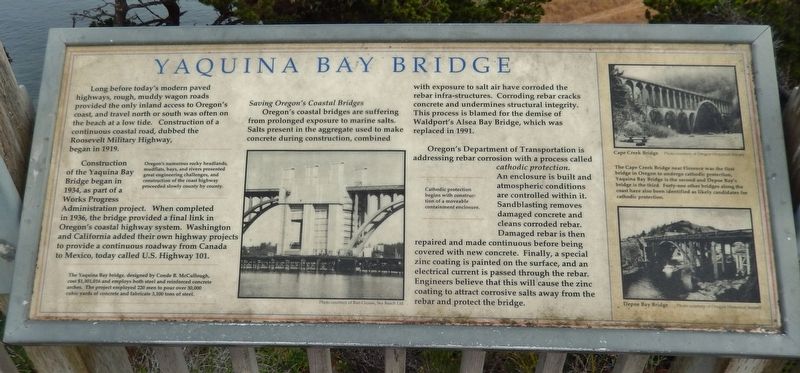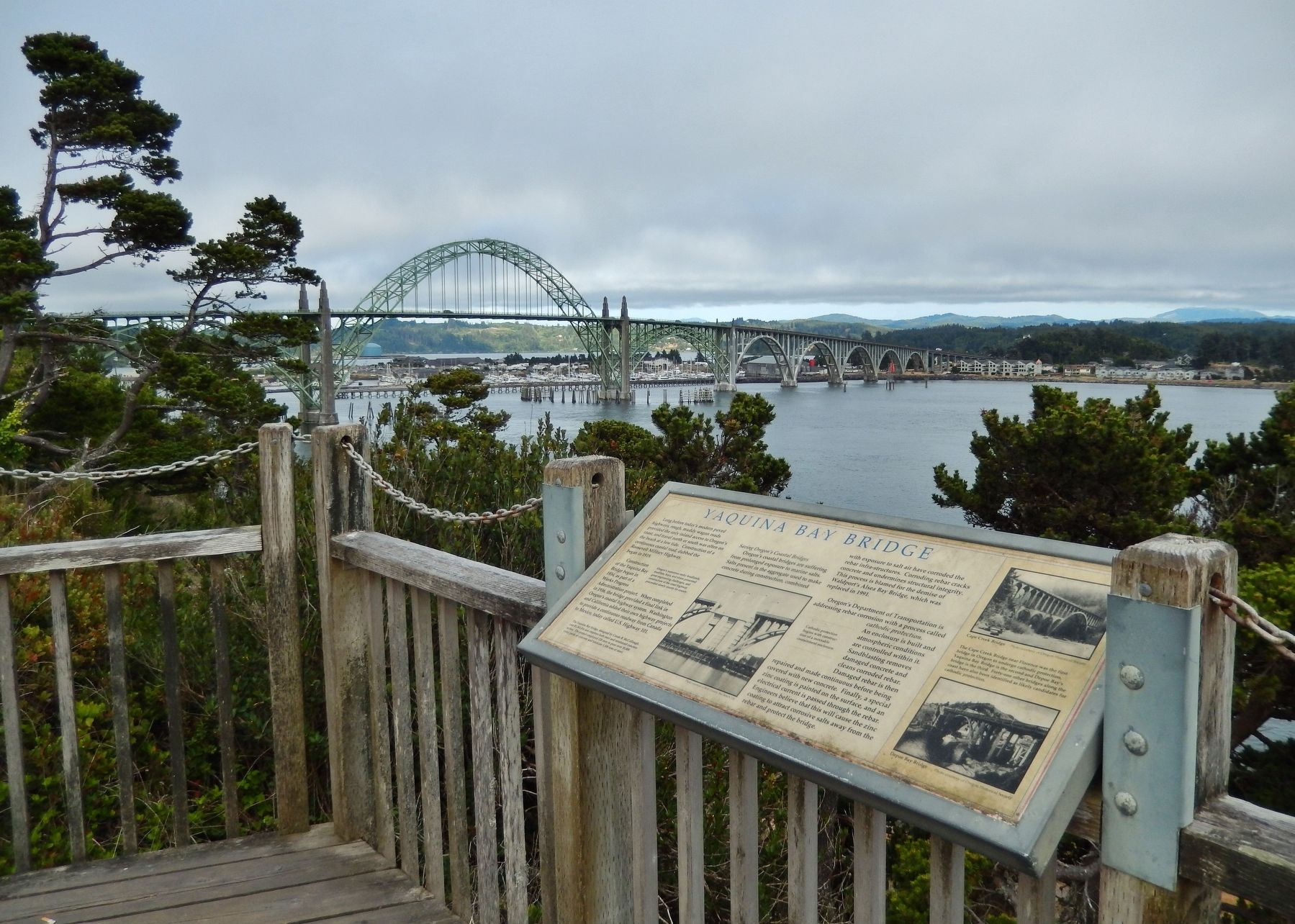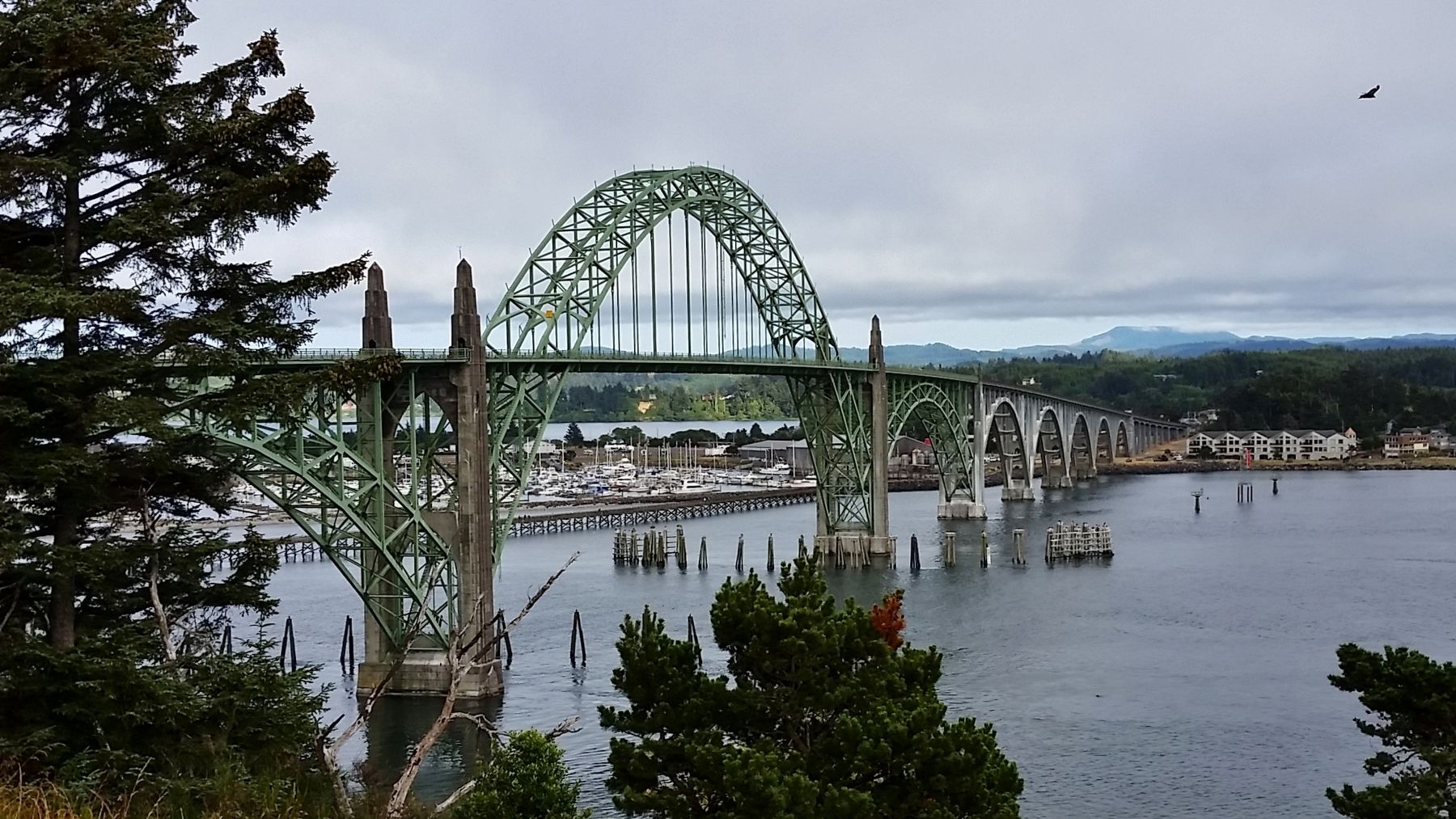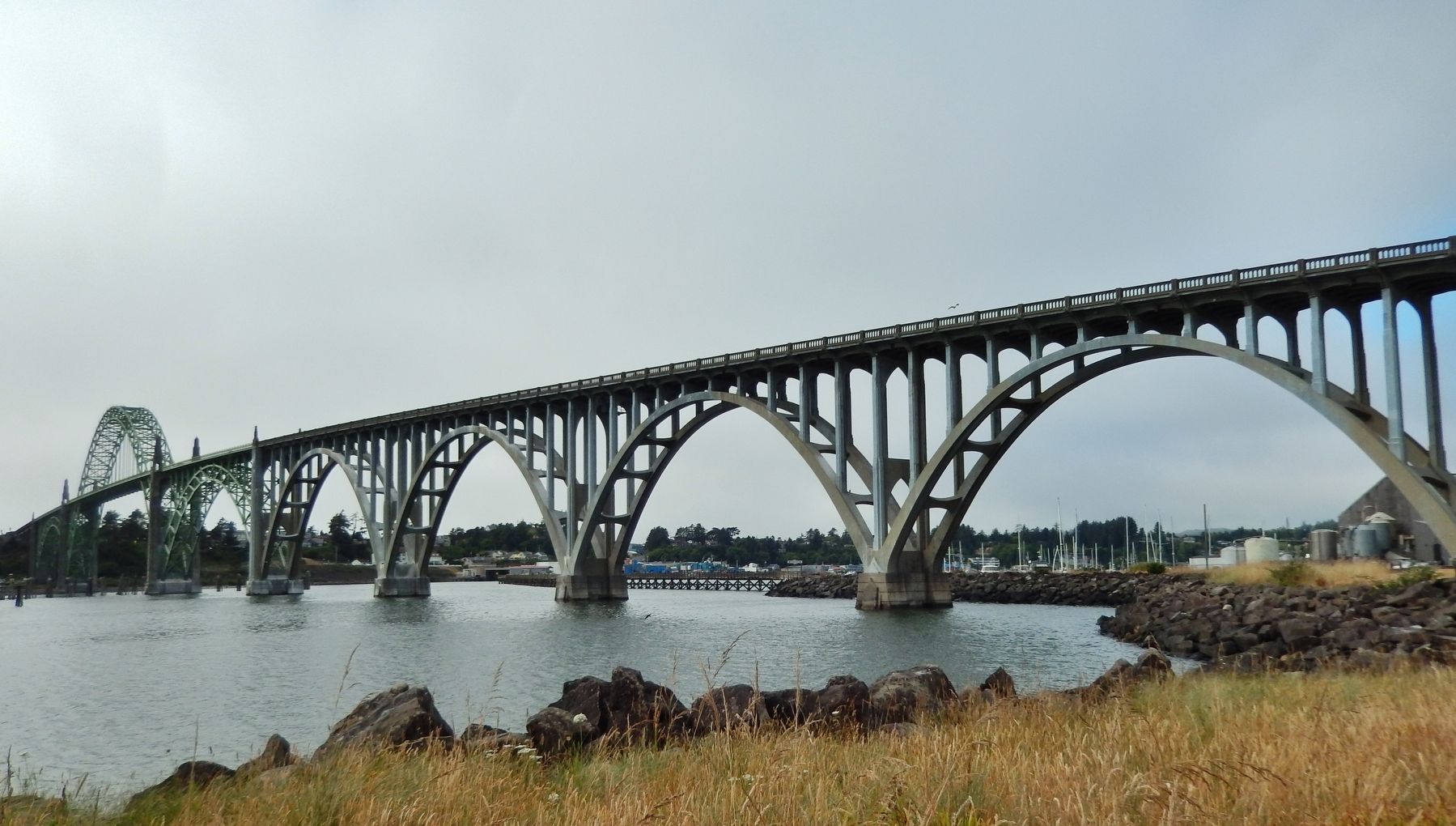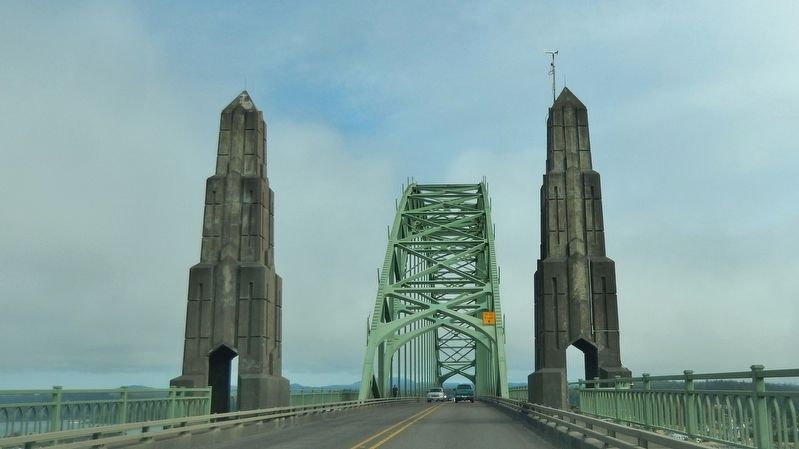Newport in Lincoln County, Oregon — The American West (Northwest)
Yaquina Bay Bridge
Long before today's modern paved highways, rough, muddy wagon roads provided the only inland access to Oregon's coast, and travel north or south was often on the beach at a low tide. Construction of a continuous coastal road, dubbed the Roosevelt Military Highway, began in 1919.
Construction of the Yaquina Bay Bridge began in 1934, as part of a Works Progress Administration project. When completed in 1936, the bridge provided a final link in Oregon's coastal highway system. Washington and California added their own highway projects to provide a continuous roadway from Canada to Mexico, today called U.S. Highway 101.
Oregon's numerous rocky headlands, mudflats, bays, and rivers presented great engineering challenges, and construction of the coast highway proceeded slowly county by county.
The Yaquina Bay bridge, designed by Conde B. McCullough, cost $3,301,016 and employs both steel and reinforced concrete arches. The project employed 220 men to pour over 30,000 cubic yards of concrete and fabricate 3,100 tons of steel.
Saving Oregon's Coastal Bridges
Oregon's coastal bridges are suffering from prolonged exposure to marine salts. Salts present in the aggregate used to make concrete during construction, combined with exposure to salt air have corroded the rebar infra-structures. Corroding rebar cracks concrete and undermines structural integrity. This process is blamed for the demise of Wald port's Alsea Bay Bridge, which was replaced in 1991.
Oregon's Department of Transportation is addressing rebar corrosion with a process called cathodic protection. An enclosure is built and atmospheric conditions are controlled within it. Sandblasting removes damaged concrete and cleans corroded rebar. Damaged rebar is then repaired and made continuous before being covered with new concrete. Finally, a special zinc coating is painted on the surface, and an electrical current is passed through the rebar. Engineers believe that this will cause the zinc coating to attract corrosive salts away from the rebar and protect the bridge.
The Cape Creek Bridge near Florence was the first bridge in Oregon to undergo cathodic protection. Yaquina Bay Bridge is the second and Depoe Bay’s bridge is the third. Forty-one other bridges along the coast have also been identified as likely candidates for cathodic protection.
Topics. This historical marker is listed in these topic lists: Architecture • Bridges & Viaducts • Man-Made Features • Roads & Vehicles. A significant historical year for this entry is 1934.
Location. 44° 37.401′ N, 124° 3.785′ W. Marker is in Newport, Oregon, in Lincoln County. Marker can be reached from Yaquina Bay State Park Road west of Oregon Coast Highway (U.S. 101). Marker is located in Yaquina Bay State Recreation Site, at the north end of the Yaquina Bay Bridge, overlooking the bridge Yaquina Bay. Touch for map. Marker is in this post office area: Newport OR 97365, United States of America. Touch for directions.
Other nearby markers. At least 8 other markers are within walking distance of this marker. Yaquina Bay (a few steps from this marker); Safety at Yaquina Bay Today (within shouting distance of this marker); Lighthouses Weren't Enough (within shouting distance of this marker); Lighthouses of the Oregon Coast (within shouting distance of this marker); Yaquina Bay Light (within shouting distance of this marker); United States Coast Guard Motor Lifeboat CG 36503 (approx. 0.4 miles away); Protecting the Coast (approx. half a mile away); Reeling Them In (approx. half a mile away). Touch for a list and map of all markers in Newport.
Related markers. Click here for a list of markers that are related to this marker.
Also see . . .
1. Yaquina Bay Bridge.
The Yaquina Bay Bridge spans Yaquina Bay south of Newport, Oregon. The Yaquina Bay Bridge is one of 5 major bridges on the Oregon Coast Highway designed by Conde B. McCullough. It superseded the last ferry crossing on the highway. The bridge uses Art Deco and Art Moderne design motifs as well as forms borrowed from Gothic architecture. The Gothic influence is seen in the balustrade, which features small pointed arches, and in the arches of the side span piers. The ends of the bridge are augmented by pedestrian plazas that afford a view of the bridge and provide access to the parks at the landings by stairways. (Submitted on January 31, 2018, by Cosmos Mariner of Cape Canaveral, Florida.)
2. Notable Oregonians: Conde McCullough - Bridge Engineer.
McCullough came to Oregon in 1916 to teach structural engineering at the Oregon Agricultural College (known today as OSU). He moved to Salem in 1919 to become State Bridge Engineer. McCullough headed the Oregon State Highway Department’s bridge design and construction program for eighteen years. The pinnacle of McCullough’s career in Oregon was completion of five major bridges along the Oregon Coast Highway in 1936 - the Yaquina Bay Bridge at Newport, the Alsea Bay Bridge at Waldport, the Siuslaw River Bridge at Florence, the Umpqua River Bridge at Reedsport, and the Coos Bay Bridge at Marshfield/North Bend. Many of McCullough’s bridges are rich in architectural detail; the finest among them are embellished with classical, Gothic, and Art Deco/Moderne elements. (Submitted on January 31, 2018, by Cosmos Mariner of Cape Canaveral, Florida.)
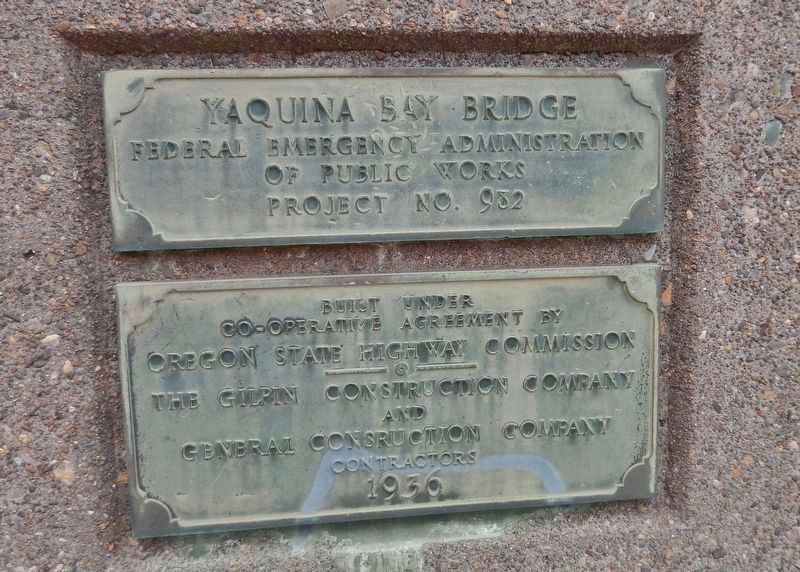
Photographed By Cosmos Mariner, July 6, 2015
6. Yaquina Bay Bridge Construction Plaque
Yaquina Bay Bridge
Federal Emergency Administration
of Public Works
Project No. 982
Built under
Co-operative Agreement by
Oregon State Highway Commission
The Gilpin Construction Company
and
General Construction Company
contractors
1936
Credits. This page was last revised on February 2, 2018. It was originally submitted on January 30, 2018, by Cosmos Mariner of Cape Canaveral, Florida. This page has been viewed 297 times since then and 22 times this year. Photos: 1. submitted on January 30, 2018, by Cosmos Mariner of Cape Canaveral, Florida. 2, 3, 4, 5, 6. submitted on January 31, 2018, by Cosmos Mariner of Cape Canaveral, Florida. • Andrew Ruppenstein was the editor who published this page.
